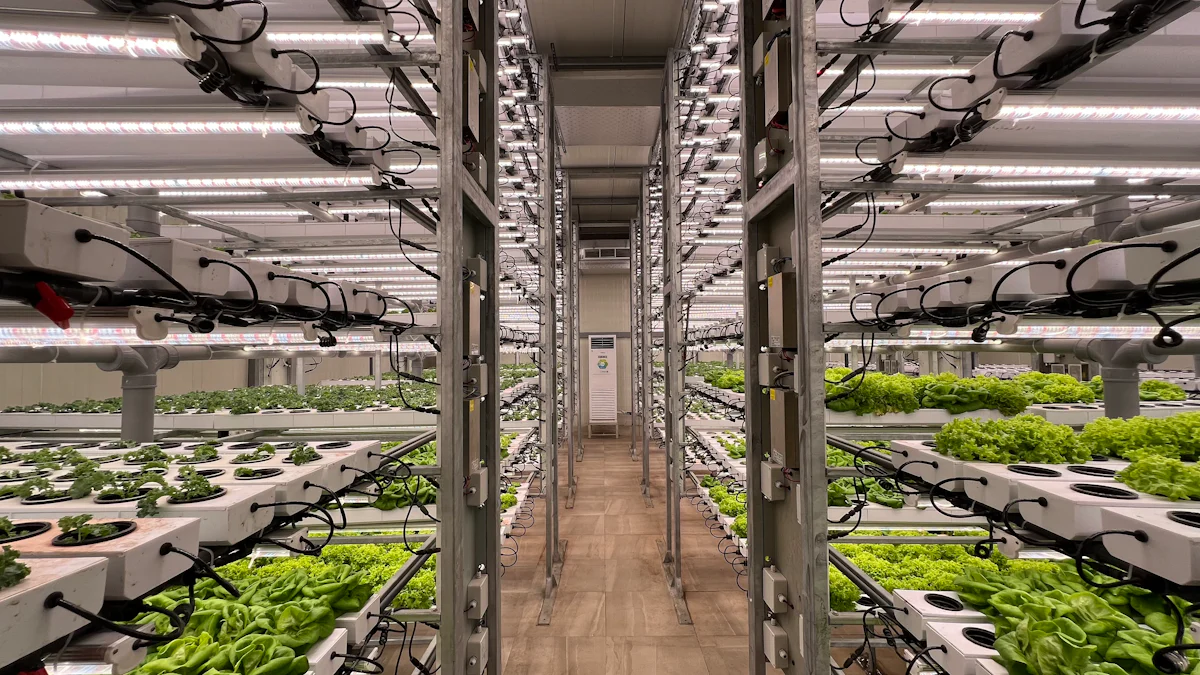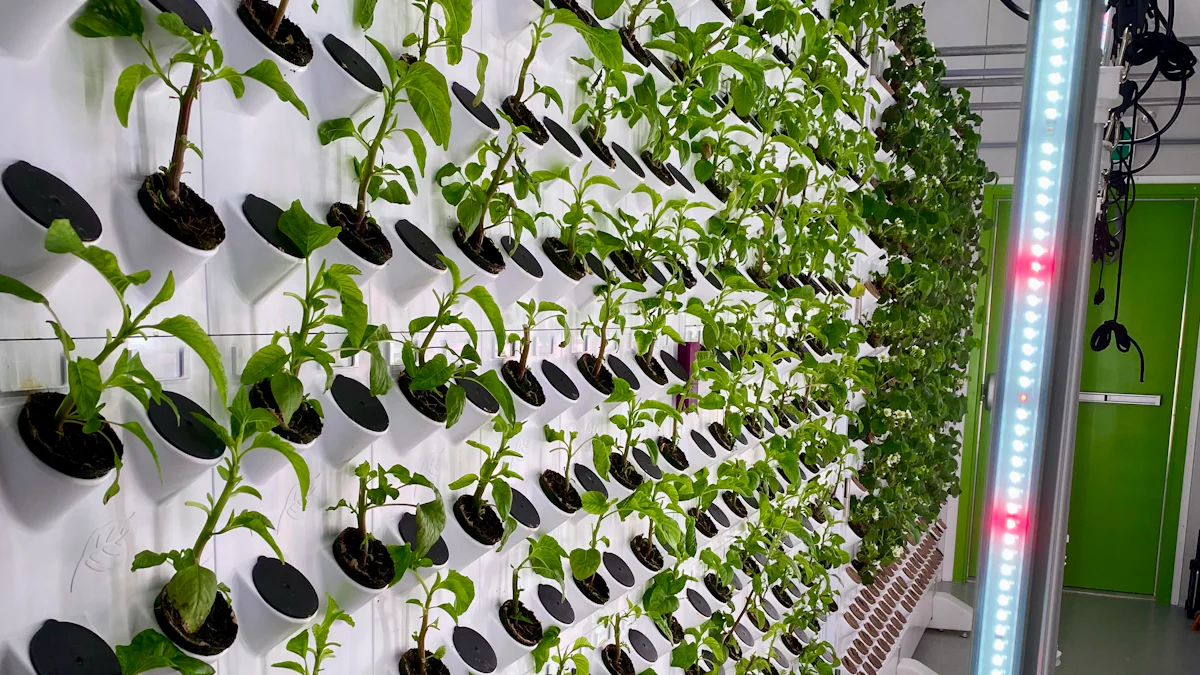Top Hydroponic Systems for Leafy Greens in Commercial Farming
Hydroponics has transformed how you grow leafy greens. It eliminates soil, allowing plants to thrive in nutrient-rich water. This method accelerates growth, boosts yields, and conserves resources. Choosing the right Hydroponic Systems for commercial farming ensures efficiency and profitability. Your success depends on selecting a system tailored to your needs.
Key Takeaways
- Hydroponics helps plants grow faster and produce more food. Leafy greens can be ready to harvest 50% quicker, giving faster profits.
- Picking the best hydroponic system is very important. Systems like NFT and DWC work well because they save time and can grow with your needs.
- Hydroponics saves resources by using 90% less water than soil farming. This saves money and is better for the environment.
Overview of Hydroponic Systems for Leafy Greens
Nutrient Film Technique (NFT)
The Nutrient Film Technique (NFT) is one of the most popular hydroponic systems for commercial farming. It uses a shallow stream of nutrient-rich water that flows continuously over the roots of your plants. This system works best for leafy greens like lettuce and spinach because they thrive in low-maintenance setups. You can achieve high yields with NFT since it allows plants to absorb nutrients efficiently. However, you need to monitor the water flow carefully. Any interruption can dry out the roots quickly.
Deep Water Culture (DWC)
Deep Water Culture (DWC) involves suspending plant roots in oxygenated nutrient solutions. This system is simple and cost-effective, making it ideal for beginners. You can grow leafy greens faster with DWC because the roots have constant access to water and nutrients. It also requires less maintenance compared to other systems. However, you must ensure proper aeration to prevent root rot.
Aeroponics
Aeroponics takes hydroponics to the next level by suspending plants in air while misting their roots with nutrient solutions. This method delivers maximum oxygen to the roots, promoting rapid growth. You can grow high-quality leafy greens with minimal water usage. Aeroponics requires precise control of misting intervals and nutrient delivery, which might demand more technical expertise.
Ebb and Flow (Flood and Drain)
Ebb and Flow systems flood the plant roots with nutrient solutions at set intervals and then drain them back into a reservoir. This cycle ensures your plants receive both nutrients and oxygen. It’s a versatile system that works well for leafy greens. However, you need to manage the timing and frequency of flooding to avoid overwatering or drying out the roots.
Vertical Hydroponics
Vertical hydroponics maximizes space by stacking plants in vertical towers. This system is perfect for commercial farming where space is limited. You can grow a large number of leafy greens in a small area. Vertical systems often use techniques like NFT or aeroponics to deliver nutrients. While they save space, they may require more initial investment and maintenance.
Top Hydroponic Systems for Commercial Farming

General Hydroponics WaterFarm - Features, Pros, and Cons
The General Hydroponics WaterFarm is a reliable choice for small-scale commercial setups. It uses a drip irrigation system to deliver nutrients directly to the roots. This system is compact and easy to assemble, making it beginner-friendly. You can grow leafy greens efficiently with minimal water usage. However, it may not scale well for larger operations. Regular cleaning is also necessary to prevent clogging in the drip lines.
Pros:
- Affordable and easy to set up.
- Conserves water effectively.
- Suitable for beginners.
Cons:
- Limited scalability for large farms.
- Requires frequent maintenance.
AeroGarden Farm 24Plus - Features, Pros, and Cons
The AeroGarden Farm 24Plus offers a high-tech solution for growing leafy greens. It features automated lighting and nutrient delivery, ensuring optimal growth conditions. You can control the system remotely using a smartphone app. This makes it ideal for those who value convenience. However, the initial cost is higher compared to other systems. It also works best for smaller commercial operations.
Pros:
- Automated features simplify management.
- Remote control via app.
- High-quality build and design.
Cons:
- Expensive initial investment.
- Limited capacity for large-scale farming.
CropKing Nft Lettuce System - Features, Pros, and Cons
The CropKing NFT Lettuce System is designed specifically for leafy greens. It uses the Nutrient Film Technique, which ensures efficient nutrient delivery. This system supports large-scale production, making it perfect for commercial farming. You can achieve consistent yields with minimal resource usage. However, it requires careful monitoring to prevent pump failures or nutrient imbalances.
Pros:
- Optimized for leafy greens.
- High yield potential.
- Scalable for large operations.
Cons:
- Requires constant monitoring.
- Vulnerable to pump malfunctions.
AmHydro Commercial DWC System - Features, Pros, and Cons
The AmHydro Commercial DWC System is a robust option for growing leafy greens. It suspends plant roots in oxygenated nutrient solutions, promoting rapid growth. This system is scalable and supports high-density planting. You can expect excellent yields with consistent quality. However, it demands proper aeration and regular maintenance to prevent root issues.
Pros:
- Scalable for commercial use.
- High-density planting increases yield.
- Promotes fast growth.
Cons:
- Requires aeration equipment.
- Maintenance can be time-consuming.
Tower Garden FLEX Vertical System - Features, Pros, and Cons
The Tower Garden FLEX Vertical System maximizes space by growing plants in vertical towers. It uses aeroponics to deliver nutrients, ensuring efficient water usage. This system is ideal for urban farms or areas with limited space. You can grow a variety of leafy greens year-round. However, the setup cost is higher, and it requires regular monitoring to maintain performance.
Pros:
- Saves space with vertical design.
- Efficient water and nutrient usage.
- Suitable for urban farming.
Cons:
- High initial cost.
- Demands regular monitoring.
Key Considerations When Choosing a Hydroponic System
Scalability for Commercial Operations
Scalability plays a crucial role in commercial farming. You need a system that can grow with your business. Start by evaluating how easily the system can expand to accommodate more plants. Systems like vertical hydroponics or large-scale NFT setups often offer better scalability. Consider whether the system supports high-density planting without compromising plant health. A scalable system ensures you can meet growing market demands without overhauling your setup.
Maintenance Requirements
Maintenance impacts both time and cost. Choose a system that aligns with your available resources. For example, Deep Water Culture systems require regular aeration checks, while NFT systems need constant monitoring of water flow. Simpler systems may save time but could limit yield potential. Always assess the maintenance needs of your chosen system to avoid unexpected challenges.
Cost and Return on Investment
Initial costs vary widely among hydroponic systems for commercial farming. Compare the upfront investment with the potential return. Systems like aeroponics may cost more initially but often deliver higher yields. Calculate operating expenses, including electricity, water, and nutrients. A system with a balanced cost-to-yield ratio ensures long-term profitability.
Yield Potential and Crop Quality
Yield potential directly affects your revenue. Look for systems designed for leafy greens, such as NFT or DWC. These systems often produce consistent, high-quality crops. Evaluate how well the system maintains nutrient delivery and oxygen levels. A system that maximizes yield while maintaining crop quality will boost your business success.
Space and Layout Optimization
Space efficiency is vital, especially in urban or indoor farming. Vertical hydroponics offers a compact solution by utilizing vertical space. Assess the layout of your farm and choose a system that fits seamlessly. Efficient space usage allows you to grow more crops without requiring additional land.
Advantages of Hydroponics for Leafy Greens

Faster Growth Rates
Hydroponics accelerates plant growth by providing direct access to nutrients and oxygen. Unlike traditional soil farming, where roots expend energy searching for nutrients, hydroponic systems deliver everything plants need right to their roots. This efficiency allows leafy greens like lettuce and kale to grow up to 50% faster. You can harvest crops more frequently, which means quicker returns on your investment.
Higher Yield per Square Foot
Hydroponic systems maximize space utilization. By growing plants closer together and often vertically, you can produce significantly more leafy greens in the same area compared to soil farming. This is especially beneficial for urban or indoor farms where space is limited. Higher yields per square foot mean you can meet market demands without needing additional land.
Water and Nutrient Efficiency
Hydroponics uses up to 90% less water than traditional farming. The closed-loop systems recycle water, ensuring minimal waste. Nutrients are delivered directly to the plants, reducing runoff and environmental impact. This efficiency not only conserves resources but also lowers operational costs.
Reduced Pest and Disease Risks
Without soil, many pests and diseases that typically harm crops are eliminated. You can grow leafy greens in a controlled environment, reducing the need for pesticides. This results in healthier, chemical-free produce for your customers.
Year-Round Production
Hydroponics allows you to grow leafy greens regardless of the season. By controlling light, temperature, and humidity, you can maintain optimal growing conditions year-round. This ensures a consistent supply of fresh produce, even during off-seasons, giving you a competitive edge in the market.
Choosing the right hydroponic system ensures your farm thrives. Systems like NFT, DWC, and vertical hydroponics offer unique benefits tailored to different needs. Align your choice with your goals and resources. Hydroponics boosts yields, saves resources, and supports year-round farming. Start today to embrace sustainable, profitable agriculture and meet growing market demands. 🌱
FAQ
What is the best hydroponic system for beginners?
Deep Water Culture (DWC) is ideal for beginners. It’s simple, cost-effective, and requires minimal technical expertise. You can achieve great results with basic maintenance.
How much space do vertical hydroponic systems save?
Vertical systems can reduce space usage by up to 90%. They stack plants vertically, making them perfect for urban farms or areas with limited land.
Can hydroponics work without electricity?
Most systems need electricity for pumps and lights. However, you can use solar panels or manual systems like Kratky for off-grid setups.











